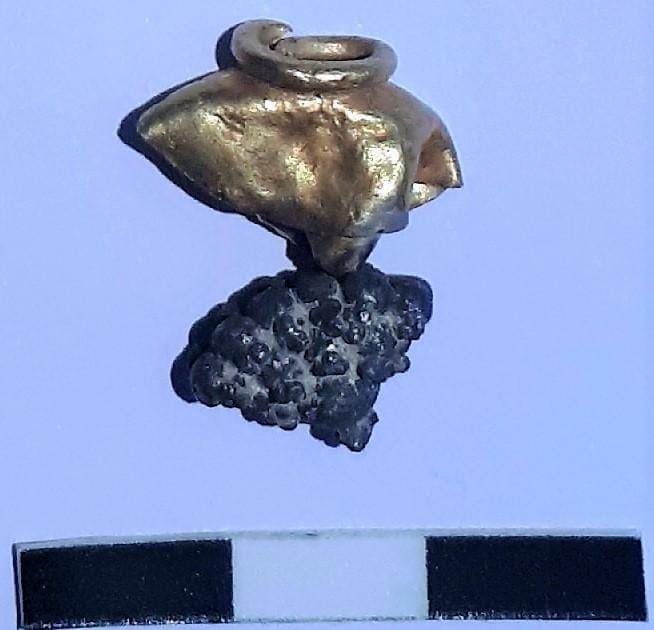Archaeologists from the University of North Carolina at Charlotte recently announced that they and Israeli colleagues in the “Mount Zion Archaeological Project” have uncovered poignant remains from the brutal day Babylonian soldiers pillaged the city of Jerusalem around 587/586 BCE.

A piece of gold and silver jewelry from the 587/586 destruction area in Jerusalem. Credit: Mt Zion Archaeological Expedition/Rafi Lewis
Nebuchadnezzar’s forces had previously defeated Jerusalem in 597, but chose to take its leading citizens into exile without destroying a perfectly fine city that could be of use to them. They installed the former king’s uncle on the throne, renamed him Zedekiah, and ordered him to send annual tribute payments — or else.
About a decade later, Zedekiah decided not to send the tribute, and soon found out what “or else” meant. Nebuchadnezzar sent his armies back and after a long siege, they swept into the city, killing and maiming and raping, pillaging anything of value, and burning the rest. Zedekiah’s sons were murdered in his sight, and then his eyes were put out before he was carried in chains to Babylon.
It was a really bad day.
Archaeologists with the project, including James Tabor and Shimon Gibson of UNC-Charlotte, have been digging at a site south of the Temple Mount and not far from the Pool of Siloam for more than a decade. The site is outside of the current city walls, built in the 16th century CE by the Ottoman Sultan Suleiman I, but would have been inside the city during the seventh century BCE. This summer, the project announced the discovery of an ashy destruction layer bearing pottery characteristic of the early sixth century — along with Scythian arrowheads and a small piece of gold and silver jewelry.

An arrowhead of the “Scythian” type used by Babylonian archers, found in a 587/586 destruction layer in Jerusalem. Credit: Mt Zion Archaeological Expedition/Virginia Withers
Arrowheads of that type are well known from the seventh and sixth centuries BCE, and were commonly used by the Babylonians. The combination of broken oil lamps, arrowheads, and precious jewelry in a layer of burned ash indicates a time of violent destruction, according to the researchers — and the only time Jerusalem was destroyed during that period was the Babylonian conquest that leveled the city and sent thousands more Judahites into exile.
The jewelry is of particular interest, a rare bell-shaped gold cap topping a cluster of grapes made from silver. It could have been a pendant, or possibly an earring. Was it lost in the shuffle as the residents fled, or torn off in an act of violence against its owner? In any case, it ended up on the floor, stepped on or crushed by falling debris as the building burned.
The prophet Jeremiah lived in Jerusalem during that time. He had warned of the coming invasion, but many refused to hear him because they believed God’s presence in the temple would never allow the city to fall.
They were wrong.
Sometimes we may hold similar misconceptions about what might and might not happen. We may choose to ignore dire warnings about the dangers of global warming, the folly of texting while driving, or the health risks associated with overeating, smoking, or other harmful practices. If we do, it won’t take an archaeologist to explain why our precious possessions were left behind.


